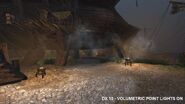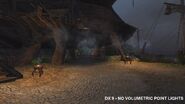DirectX 10 became available for Age of Conan on 25 March 2009, as a part of patch 1.04.5. The game can be launched in DirectX 10 mode either by selecting in the settings tab on the patcher or by running the AgeOfConanDX10 executable file.
New features include:
- HDR lighting
- Ambient occlusion (more subtle shadowing)
- Physics acting on grass and foliage
- Extravagant radial blur on fatality effects
- Volumetric lighting and fog
- Specular reflections on water
- Beautifully diffused underwater light
Comparison Images[]
General DX 10 info[]
Windows Vista includes a major update to the Direct3D API. Originally called WGF 2.0 (Windows Graphics Foundation 2.0), then DirectX 10 and DirectX Next, it features an updated shader model (version 4) — the shaders still consist of fixed stages like on previous APIs, but all stages sport a nearly unified interface, as well as a unified access to resources. The language itself has been extended to be more expressive (integer operations, nearly unlimited instructions count). In addition to the previously available vertex and pixel shader stages, the API includes a geometry shader stage that breaks the old model of one vertex in/one vertex out, to allow for more complex effects in real time. Direct3D 10 no longer uses "capability bits" to indicate which features are active on the current hardware. Instead, it defines a minimum standard of hardware capabilities which must be supported for a display system to be "Direct3D 10 compatible".
Therefore, contrary to the previous revisions of Direct3D, it requires new graphics hardware backed by WDDM-compliant drivers to run at all, whereas prior versions allow the old hardware capabilities to be addressed within the new interface. This is one of the major departure of this new API, and it is justified by Microsoft as the only way to achieve the CPU efficiency gains needed for the newest pieces of hardware without the clutter of legacy code.
Because Direct3D 10 hardware will be comparatively rare for a period of time after the release of Windows Vista, and because the Vista Premium logo program does not require Direct3D 10 to be supported, the first D3D10-compatible games will most likely still provide a Direct3D 9 render path.







